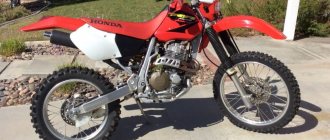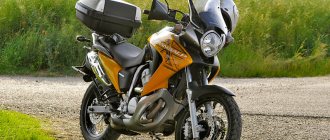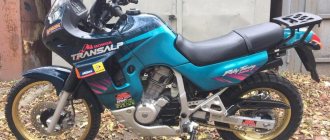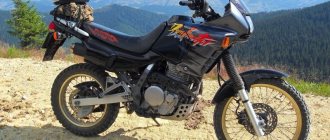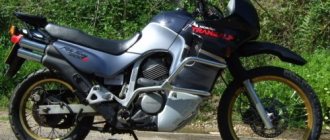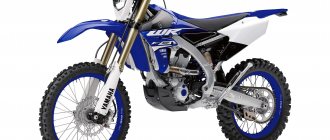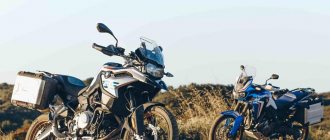XL 600 V Transalp
- Honda motorcycle model
The Honda XL 600 V Transalp enduro touring motorcycle model was produced from 1987 to 2000. At the same time, a 400 cc version of the motorcycle was created specifically for the Japanese market - the Honda XL400V Transalp, which generally differed from the Transalp 600 only in engine size.
The Honda XL600V Transalp model was export-oriented and is practically not found in Japan. Honda XL400V Transalp, on the contrary, is very popular in Japan and is widely represented at local auctions, but is practically not found in Europe and the USA.
A special feature of the Honda XL600V Transalp is a V-shaped 2-cylinder 6-valve liquid-cooled engine producing 50-55 hp. (depending on the year of manufacture) power and 52.6 Nm of torque. The engine is tuned for confident traction at low and medium speeds, without dips or snags. Maximum engine performance is achieved at 6000-8000 rpm. This engine was also installed on a cruiser - Honda Steed 600.
Features of the Honda Transalp 600 include a steel frame, disc brakes (since 1991), simple suspension in the form of a conventional telescopic fork at the front and a progressive monoshock absorber at the rear, a 5-speed gearbox, a chain drive and 187 kg of dry weight.
Bike features
The Honda XL 600 V Transalp is a dream motorcycle for many travelers, and there are a number of reasons for this:
- well-developed wind protection;
- capacity;
- fairly large fuel tank.
The machine is in many ways inferior to modern bikes of this type: it does not have much power, and its other components are somewhat outdated. However, even now this model can compete with many newfangled touring enduros, and even surpass some.
Estimated cost
A club of fans of the model in question has been organized in the Russian Federation , which unites owners of the Honda XL650V Transalp.
They regularly improve and tune their bikes, hold demonstration rides and thematic forums.
Here, those who plan to purchase the Transalp 650 model can get practical advice and recommendations on choosing a motorcycle.
The great advantage of Honda Transalp motorcycles is their amazing potential, which is minimally affected by age and mileage (with proper maintenance).
For this reason, motorcycles of this model remain in demand and quite expensive .
Among other things, there is no worthy alternative to them in the mid-size endurik segment.
Thus, relatively new copies of the bike are sold at a price of 250,000 rubles ($5,000), while “seasoned horses” with hundreds of kilometers of mileage are inferior in price only slightly - a maximum of 40 - 50 thousand.
The first thing that catches your eye when you see the Irbis 150 ATV is its modern original design, made in a sporty style.
This ATV is created for young off-road conquerors:
Engine
The motorcycle is a 600 cc motorcycle, but, as always, the engine displacement is slightly smaller and amounts to 583 cm³. By type it is a V-shaped, four-stroke, two-cylinder unit. It is liquid cooled. The XL 600 V has a carburetor fuel supply system.
The peak performance of the engine here is as follows: at 6000 rpm the torque is 52 Nm, and at 8000 rpm the power reaches 50.3 hp. The maximum speed of the motorcycle is 164 km/h, and the car accelerates to 100 km/h in 5.6 seconds. This is quite good for a touring enduro.
The motorcycle season will start soon, and I'm sick (( On the other hand, so much the better - there is time to finally write my review of the Honda XL 600 Transalp motorcycle. I'll tell you how and why I chose it and sum up the last season. Be careful, a lot of letters !
I'll start from a little distance. In my previous post, I wrote about my first motorcycle. In fact, he is my first only formally. Before that there were all sorts of Voskhods, Minskis, Dneprs from my grandfather’s garage, on which I dashingly rode around the village throughout my childhood, to the envy of the boys. But the SYM XS 125 was my first motorcycle in the legal sense.
Many people advise starting your life with small-sized classics. I fully support this opinion, and here's why. Riding around the village on scooters since early childhood, I always thought that I knew how to ride. However, falling from a 125 cc hole on a supermarket site at a speed of 15 km/h shook my pathos. It turned out that the ability to lift a Dnepr stroller and make a “police” U-turn on it does not add to your driving skills in the city!
An equally important advantage of the “no character” technique, which is my (not yet sold) octagon, is its versatility. I was able to try it as a city bike, as a long-distance bike and even as a light enduro bike. The last two points, as you understand, are very relative, but still. The task of the first mot is to give an idea of which direction to develop, and Sim coped with this. I realized for myself that I want long-distance trucks!
When I imagined traveling on a motorcycle, I always imagined a chopper-like technique. And if I had more money, a couple of years ago, I would of course have bought some kind of Honda Steed or something like that. However, after walking around the showrooms and thinking about it, I abandoned the Chapper as a kilometer eater.
For this we must thank little Sim. Trial long-distance trips on it showed that a motorcycle for such tasks must have a number of qualities: a moderately powerful engine, for confidence in the cruise and when overtaking; developed wind protection; large wheels and enduristic suspension for a smoother ride on our roads; developed system of luggage fastenings. As you can see, there is no smell of chopper here)))
Alas, our roads are not American and in order to get to any attraction, sometimes you have to drive all the way.
What the market could offer For that amount (about $3,900 or approximately 138 thousand) in the summer of 2014, one could buy little. After I gave up the chopper, I somehow immediately set my sights on TA. Soon, on one of the well-known sites, I found a good option for my money. Transalp XL 600 1996 from Italy with 45 thousand mileage. Photos and videos showed very good condition (in comparison with the trash in Moscow showrooms that I had examined before). The seller was in Brest, but for prepayment of delivery (about 5 rubles) he sent me a motorcycle to Moscow. I paid it to the driver, after the inspection - very convenient!
The bike was in very good condition for its age, so I really think the mileage is original. I also realized that in Europe, technology, apparently due to the climate, is preserved much better than in Japan. In addition, a big advantage of Europeans is often the presence of tuning - which is not often the case on showroom models from Japan. I got front and rear bars, a good case and a touring windshield. The seller assured that all the consumables and even the oil were new, which turned out to be true. I left the season without changing anything.
Feelings of use. At first it seems that it is simply huge! Compared to everything I've ever driven. With my height of 175 cm, at first I seemed tall, but I got used to it almost immediately, because... I can completely reach the ground with my feet. Due to the high center of gravity and large front wheel, the first ride was an unusual feeling. The motorcycle seemed to have trouble steering and wobbling. The very next day, I completely got used to the technology and this feeling disappeared completely. Particularly worth noting is the wind protection - in the rain, only the legs get wet up to the middle of the shin (you need to buy boots), the tips of the elbows and the helmet. Doesn't blow away on the highway, incl. oncoming trucks. I have a tall “touring” glass. The cut-off air hits the forehead, which creates noise in the helmet. I plan to solve this problem by installing an additional collective farm spoiler. The wind protection on the handlebars performed very well, I recommend it for long trips.
The suspension allows you not to pay attention to the quality of the asphalt - the motorcycle simply flies over the uneven surfaces. There was a case, at the entrance to Tver, the road there is not very good, a guy on a CB 400 catches up with me and waves, saying, stop. They got up, he said: “After 100 km/hour, my bike is spinning like crazy, and you’re walking around me like I’m standing!” I was driving about 130 and didn’t even strain. We sat on each other's boats. CB is a good motorcycle, but somewhat puny, not for our roads IMHO.
A few more words can be said about the suspension - it is really good, especially coupled with the 21m wheel, any asphalt becomes acceptable. I went with my wife (45 kg.) to the lake. Seliger, took a load (about 30 kg, approximately). On the move there is practically no difference: the frame does not cross, the pendulum does not move, there is enough power. This is probably the main advantage of the six hundred over the four hundred. In general, I advise everyone to take Transalp 600 and higher . For comparison, I drove a Chinese copy of the Yamaha Virago 400 - it’s not a cake, the engine needs to be turned after 100.
Brakes The brakes are so-so. I don’t quite feel how much I need to press, I’m afraid the wheel will skid. This is probably due to the mass and one disk. Since 1997, the TA began to be equipped with two discs in front, probably the brakes are better. There is a rear brake, but it needs to be worked carefully; the wheel can jam. I will try to change the situation with reinforced hoses and a new brake system.
Engine – I like it. Of course, I would like the consumption (5.5 liters per hundred) to be less, but nothing can be done about it. Otherwise, there are no complaints. Doesn't burn oil, doesn't eat brain. It's a good engine, a lot has been written about it. Vibrates moderately at 130-140. The box is clear. In general, Honda)
Subtotal
Breakdowns: During half of the 2014 season, I drove about 5 thousand kilometers. During this time, it turned out that the battery was on its last days (sometimes it did not want to turn the starter). The hook of the trunk lock broke - it was my own fault, the plastic trunk cannot be loaded too heavily. The clutch cable began to fray a little; I bought a Chinese equivalent for $10 as a reserve while I drive with this one. That's all for now.
Tuning: Installed a Chinese waterproof cigarette lighter with USB for $10, a very useful thing. I ordered light bulbs for the arches so that, like a goose, I bought aluminum panniers cheaply for the occasion, I will be working on a collective farm and there will be a separate post about this. I want to set an alarm. I want an MRA wind cut-off device, but not for the exorbitant money they ask for it in Europe (80 euros).
I ordered light bulbs for the arches so that, like a goose, I bought aluminum panniers cheaply for the occasion, I will be working on a collective farm and there will be a separate post about this. I want to set an alarm. I want an MRA wind cut-off device, but not for the exorbitant money they ask for it in Europe (80 euros).
Perhaps that's all. If anyone has questions, ask, I will answer! Thank you for your attention!
Dimensions and weight
The wheelbase of the motorcycle reaches 1505 mm. Its seat height is 850 mm, and its overall height is 1300 mm. The width of the model is quite large - as much as 905 mm, while the length of the motorcycle is 2280 mm. Without fuel, the bike weighs 189 kg, and with it - 202 kg. The volume of its fuel tank reaches 18 liters, of which 3.5 liters are reserve.
These dimensions make the XL 600 V not the most comfortable for short people. In addition, the bike is unlikely to be suitable for people with a slight build, because it weighs quite a lot. Based on the dimensions, fuel consumption per 100 km of road is quite acceptable and ranges from 5 to 6 liters.
Disadvantages of the model
- The sore spot of the Honda Transalp is the steering column bearing and mono shock absorber. Their condition should be periodically checked and timely repairs carried out.
- If you often test the suspension for strength when driving over rough terrain, you will have to replace individual parts.
- There are problems finding spare parts.
- There may be cracks in the attachment of the radiator to the frame, which leads to fluid leaks.
The Honda Transalp motorcycle is distinguished by its versatility of use. This allows you to enjoy long tourist trips and not think about what kind of surface you will have to drive on. Reviews from owners confirm the reliability and high quality of the equipment. The cruising speed is 110-130 km/h, which allows you not only to enjoy a comfortable ride, but also to admire the views of nature. The power of the motorcycle is quite enough not only for a beginner, but also for an experienced driver. This is an ideal option for a leisurely tourist trip, the purpose of which is not to test the speed limit, but to escape from the bustle of the city.
Chassis and brakes
The motorcycle has a semi-duplex frame made of steel. From its design you can immediately understand that this is an enduro; the shapes of this class of bikes are very characteristic. The wheels are quite large, spoked rims. The comfortable steering wheel is typical in size for the class.
The XL 600 V is characterized by long-travel suspensions. At the rear, this is a pendulum version with a monoshock absorber, and the travel of this suspension is 187 mm. The front suspension has a travel of 200 mm and is a 41 mm telescopic fork.
The rear brakes here are discs with dimensions of 240 mm. It is assisted by a single-piston caliper. At the front, the XL 600 V has two discs, 256 mm each, as brakes. They are helped by two-piston calipers. Considering the not particularly powerful engine, such a braking system is quite sufficient.
Second generation (2000–2008) Honda XL 650 V Transalp
In 2000, engineers were ready for the first serious update. The main theme was restyling and increasing engine capacity to 647 cm3 by increasing the cylinder diameter by 4 mm. The motorcycle remains fundamentally the same. Previous problems with switches are a thing of the past.
The second generation Transalp has become noticeably prettier. The front now sports a new headlight and complex-shaped turn indicators. A small luggage compartment appeared under the seat. The archaic gas tap gave way to a full-fledged fuel sensor. All the plastic was rounded, and the lines became smoother. The overall dimensions, braking system and chassis have not undergone any changes, with the exception of a narrower rear wheel and the presence of preload adjustments in the rear shock absorber. Like many other Honda motorcycles, Transalp has acquired an electronic HISS system. To reduce toxicity, a catalytic converter is integrated into the exhaust system.
The speedometer cable drive needs regular monitoring (this is also true for the XL 600). Often, the plastic gear in its gearbox is cut off due to insufficient lubrication, severe bending of the cable, or wear of the housing. The disease is treated by replacing obsolete parts and modernizing the drive.
In 2005, there were slight cosmetic changes - a new saddle appeared, a new steering wheel, the rims began to be painted black, the type of plastic and the ends of the exhaust pipe changed slightly.
The trend is that each next generation of Honda Transalp differs from the previous one in its increasingly decreasing off-road potential - the weight increases, the plastic becomes thinner and its fasteners are more delicate, the design becomes more complicated in places. Among devoted fans of the model who want to delve deeper into the impassable depths, the prepared XL 600 is considered a better choice than the XL 650. The situation with spare parts and service is generally better, but still far from ideal.
History of changes
Throughout its industrial journey, the model has gone through several main stages:
- 1987 – start of production;
- 1989 – the motorcycle receives minor changes and appears in the USA;
- 1991 – rear brake changes from drum to disc;
- 1994 – new fairing and headlight;
- 1996 – slight change to the fork;
- 1997 – produced only in Italy;
- 1999 is the last year of production.
Perhaps the XL 600 V Transalp is one of the best representatives of touring enduros throughout the entire era of the motorcycle industry.
Design solutions
The original version of the 650 Transalpa delighted with its outstanding speed characteristics and level of comfort.
However, this was not enough for the designers, and five years after the presentation (in 2005), the model was restyled.
The modifications were designed to give the motorcycle a more sporty character and appearance.
As a result, the neat protective fairing combined with the windshield became more aesthetically pleasing, the wheel rims received a black alumite coating and dual-purpose tires, which were in perfect harmony with the new color scheme of the 2005 model.
By the way, the rear brake disc rotor was painted in the same colors. The remaining parts and elements were treated with a special anti-corrosion compound.
Also, the updated modification received daytime running headlights and an alarm button on the remote control.
In addition to changes in appearance, the exhaust system of the motorcycle has received further improvements, as well as a frame made of steel box pipe, which has become more durable.
Comfort
The dashboard looks simple and clear. Nothing else is needed. The rational primitiveness of the instruments is a good solution for motorcycles, because it helps to quickly obtain the required information and immediately concentrate on the road again.
The windshield is tall enough to protect the eyes and face of an average-sized person, but not too large; it fits harmoniously into the overall design. Much the same can be said about containers for things: not too large so as not to interfere with aesthetics, but practical enough to meet the standards and functions of the tourist class.
Trouble-free Transalp?
Despite this, Transalp has won a large group of supporters. This is not surprising, because this is a trouble-free machine, strong and durable. And although the motorcycle looks ridiculous, you need to try hard to break it. In addition, it is a very comfortable motorcycle, not very demanding to use, and it is easy to turn into an adventure, because the range of accessories and the number of patents that make life easier for this motorcycle are enormous.
Unfortunately, the motorcycle also has shortcomings that have not disappeared despite the years and are frightening in each subsequent version. The most significant of these is the tendency to shimmy. Steering vibration appears around 80-90 km/h, and increases when driving with a central trunk.
Another disadvantage of the Honda XL700V is the low standard window glass, which is best immediately replaced with another, and poor engine protection from below. If you drive on asphalt only on a dirt road, the second problem will not apply to you, but if you like trekking, remember that the bottom cover is made of plastic, not sheet metal!
A solution that makes life a little more difficult for off-road enthusiasts is ABS, which cannot be switched off. On asphalt the system works brilliantly, but on gravel it is dull, but you have a simple solution - remove the fuse.
Transalps XL 700 V was sold in Russia about 300. These were versions RD 13A and RD 13B (2008 and 2009), as well as RD 15A and RD 15B (2010-2011). The first was produced in Spain, the second in Italy, and the letters A and B mean versions without ABS and with ABS, respectively.
Although the instrumentation does not resemble that of a farm tractor, Honda could make it better and, above all, more pleasant.
